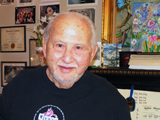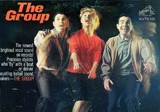Featured Stories
Sing, Sing, Sing! Martin Grusin Can Help

Martin Grusin. Photograph by Paul Hormick.

Early 1960s album cover for The Group
The walls of Martin Grusin’s Del Mar home are crowded with mementos. Photographs of family and entertainers, many of them autographed, hang next to certificates or diplomas that reflect a life of accomplishments. Along the wall by the front window are the promo photos, the 8×10-inch glossies that entertainers and celebrities hand out like candy. Among the pictures are San Diego’s best singers and bands: Ruby and the Red Hots, Mark DeCerbo, Eve Selis, and many, many others.
For the last 28 years Grusin has worked as a voice trainer, helping these singers to develop the strength and technique to sing the blues ‘ or country, rock and roll, or jazz for that matter ‘ night after night and day after day.
Everyone knows that pianists, flutists, bagpipe players, or anyone who plays an instrument, needs to practice. They have to work at the craft of making music, developing the fluidity of the fingers on a keyboard or perfecting the embouchure needed to make a note on the flute. Singers are no different. They need to strengthen their vocal cords and learn the proper techniques to produce the sounds they want their voices to make, while avoiding habits and practices that may diminish their voices or harm their vocal cords.
For Grusin the voice can be improved and strengthened through the control of breath, timing, and what Grusin terms the nondistortion of vowels. At the foundation of Grusin’s method is a system of ten manipulations of the larynx, the portion of the throat that houses the vocal cords. Like any other part of the body, daily use and exercise increase the strength of the vocal cords. For example, if a person were to spend a portion of the day singing ‘ without straining ‘ his or her voice, that person’s voice would naturally grow stronger. Grusin’s method, which is called Vocalessence, accelerates that process of strengthening. He says that with his method a singer can achieve in one year the strength and control that would normally take that singer three and a half years to develop. His method is a real hands-on approach, literally and figuratively. Grusin places his hands on either side of the singer’s throat as the singer is producing a note, putting pressure on the vocal cords. Singing the note exercises the voice, like pumping your arms in the air exercises your arm muscles. Placing pressure on the cords is like adding weights to your arms, making the exercise more productive.
Grusin started vocal instruction back in the eighties. He remembers, ‘I was teaching a music class at City College, and Harvey Williams, who was in the class, came up to me and asked, ‘Can you teach me to sing?’ I told him I could. He said, ‘How long will it take?’ I said about a year.’ And it was a year later that Williams launched his Harvey and the 52nd Street Jive, one of Southern California’s most successful review bands. Grusin has similarly recognized the inherent talent of others who were not professional singers and has been able to help them along to similar success.
‘Rock, country, jazz ‘ I can teach you to sing any style. The only type of singing that I don’t teach is opera,’ he says. Grusin teaches singers the basics; from there it’s up to the singer to specialize. Also, if a singer wants to clean up a gravelly voice, Grusin can help the vocalist achieve a clearer timbre. On the other hand, if someone wants to sing rock and roll and wants a rough edge, a rasp, a just-gargled-with-Drano sound to his or her singing, Grusin can get that singer moving along in that direction as well.
Bad breathing habits can reduce a singer’s range. Grusin says that it’s important to breath without forcing the voice. He demonstrates with his hands on his belly and shows how the belly works as a sort of bellows. If the muscles of the belly get hard, the singer is forcing his or her voice and hurting it. Emphasizing the full cycle of the voice breath cycle, Grusin says, ‘You begin singing when you finish a breath.’
Grusin explains that the voice is like a cross between a wind instrument and a stringed instrument. As a person raises the pitch of his voice, muscles around the vocal cords tighten the vocal cords, just as pulling tighter on a string produces a higher pitch when that string is plucked. At the same time, muscles in the vocal cords pull tight and make the vocal cords themselves thinner, which is also the way to make a higher note.
The singer who does everything right? The singer who has technique in spades? Grusin doesn’t hesitate for a moment with that question. ‘Sinatra,’ he says. He also mentions Ella Fitzgerald. ‘She just had a beautiful voice. A totally balanced register, a great singer.’
It’s easy to hurt your voice. And singers, who really put the vocal cords to work, have the potential to do a lot of damage to their voices. Not only does Grusin help singers to develop good singing habits and avoid hurting their voices, but he has worked with persons with damaged vocal cords and been able to reverse the damage done. In some cases, mostly due to bad vocal practice, singers develop what are called nodules, masses of tissue that grow on their vocal cords. Grusin has been able to reverse the growth of the nodules of singers plagued with this problem.
The vocalists who have worked with Grusin sing his praises. Local country rocker Eve Selis has worked with Grusin for years. ‘I wound up working with Martin when I was in a rather desperate situation,’ she says. ‘I’d been singing incorrectly for years and had caused my voice a lot of damage. I had a lot of gigs with my band, the Heroes, and lost my voice on a cold and rainy Thursday night gig. That Saturday my band, Kings Road, was opening for Crosby, Stills, and Nash, and I was going to do everything to keep that date. Martin worked with me that Friday and in that one session was able to pull my voice back to 80 percent.’ Selis sang that Friday night, her bad habits loosing her voice again. A return visit to Grusin gave her 85 percent of her voice, and the performance with CSN was a success. ‘That night Stills and Nash stayed for my whole show, and Crosby was like, ‘Who is that? We have to follow her!’
Grusin is soft-spoken, yet his voice comes across full and easy to listen to. He speaks with the diction that any radio announcer would give his right arm for. Unsurprisingly, he has been singing his whole life. The Chicago native started singing at the age of seven, when he was at camp. Recognizing his inherent talent, the grownups encouraged him to keep singing.
After serving in the military, with a case of pneumonia keeping him from being shipped overseas, Grusin moved to the big time, New York City. He sang at the Village Vanguard, Birdland, and other jazz meccas. He worked with guitarist Mundell Lowe and shared billings with John Coltrane and other jazz icons of the day. Among his good friends and associates were the bassist and violinist Johnny Frigo and the premier scat singer Dave Lambert of the legendary jazz vocal trio Lambert, Hendrix, and Ross.
Grusin assembled a successful vocal trio of his own in the early sixties. Called, of all things, The Group, the ensemble combined Grusin with fellow tenor Tom Kampman and soprano Anne Gable. Their recording legacy is an album of a dozen show tunes and jazz standards that RCA Victor released in 1963. Downbeat magazine awarded the recording Best Jazz Vocal Group for that year. Grusin arranged the music for the record with Fred Karlan and Don Sebesky, who is known as the arranger of the hit ‘Come Saturday Morning.’
Besides The Group, Grusin’s vocal ensembles performed on some of the biggest television shows, including Johnny Carson’s Tonight Show, The Shari Lewis Show, The Jim Backus Show, The Bobby Morse Show, and the perennial early morning staple, The Today Show.
After years in the limelight, Grusin moved to California and, well past the time in life that most folks start their academic career, went back to school. He earned a bachelors of music from the San Francisco Conservatory of Music and a master’s in composition, theory, and vocal research at UCSD. Doctoral research continued at UCSD through the seventies. Besides his work as a performer and teacher, Grusin is also a composer. The National Endowment for the Arts honored him with awards for two of his compositions.
Today, Grusin’s time is dedicated to helping singers. ‘People come to me, and if I don’t think that they can do it, I won’t take them on. I’ll tell you another thing. If you study with me, and you’re unsatisfied with your progress, I’ll give you your money back from all your lessons.’ He pauses and leans back in his chair. ‘In 28 years, I’ve never had to refund anybody’s money.’






